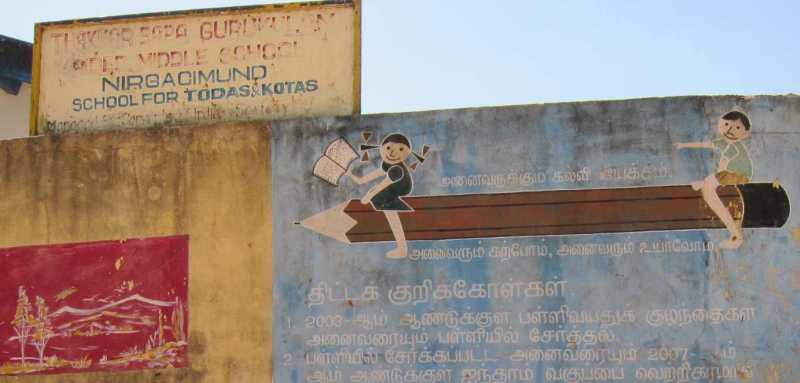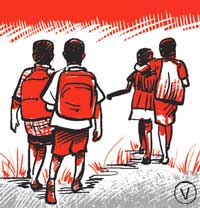
Learn more about Multi-lingual education & Assimilation >>
“Thakkar’s 1941 lecture advocated using tribal tongues as a ‘bridge’,
but in practice, even this did not happen.” | The Hindu, 13 February 2021 >>
Many children speak a home language that differs from the language of instruction in education programs. Research confirms that children learn best in their mother tongue as a prelude to and complement of bilingual and multilingual education. Whether children successfully retain their mother tongue while acquiring additional languages depends on several interacting factors. Studies show that six to eight years of education in a language are necessary to develop the level of literacy and verbal proficiency required for academic achievement in secondary school. To retain their mother tongue, children whose first language is not the medium of instruction must have: (1) continued interaction with their family and community in their first language on increasingly complex topics that go beyond household matters; (2) ongoing formal instruction in their first language to develop reading and writing skills; and (3) exposure to positive parental attitudes to maintaining the mother tongue, both as a marker of cultural identity and for certain instrumental purposes (e.g., success in the local economy or global trade).
In addition, research increasingly shows that children‘s ability to learn a second or additional languages (e.g., a lingua franca and an international language) does not suffer when their mother tongue is the primary language of instruction throughout primary school. Fluency and literacy in the mother tongue lay a cognitive and linguistic foundation for learning additional languages. When children receive formal instruction in their first language throughout primary school and then gradually transition to academic learning in the second language, they learn the second language quickly. If they continue to have opportunities to develop their first language skills in secondary school, they emerge as fully bilingual (or multilingual) learners. If, however, children are forced to switch abruptly or transition too soon from learning in their mother tongue to schooling in a second language, their first language acquisition may be attenuated or even lost. Even more importantly, their self-confidence as learners and their interest in what they are learning may decline, leading to lack of motivation, school failure, and early school leaving. […]
Enhancing learning of children from diverse language backgrounds: Mother tongue-based bilingual or multilingual education in early childhood and early primary school years | Download this report from Unesco or click here >>
Source: “Enhancing learning of children from diverse language backgrounds: Mother tongue-based bilingual or multilingual education in early childhood and early primary school years”, p. 2: Prepared for UNESCO by Jessica Ball, M.P.H., Ph.D., University of Victoria
URL: https://www.ecdip.org/docs/pdf/UNESCO%20Mother-tongue%20based%20EY%202010.pdf
Date visited: 29 January 2015
Section 29 (2) (f) of the Right of Children to Free and Compulsory Education (RTE) Act, 2009 states that “medium of instruction shall, as far as practicable, be in child’s mother tongue”. The National Curriculum Framework (NCF), 2005 emphasizes the importance of imparting primary education in the mother tongue of the child. Since education is in the Concurrent List of the Constitution, States have the liberty to decide the medium of instruction in schools. The NCF clearly states that the Three-Language Formula is an attempt to address the challenges and opportunities of the linguistic situation in India. As per the “Three Language Formula” the first language to be studied must be the mother tongue or the regional language.
Ministry of Tribal Affairs extends support to State Governments / UTs for mother tongue-based education and development of bilingual Primers for enhancement of learning achievement level amongst the Scheduled Tribe Students. So far 82 language primers have been developed by various State Governments as detailed below. […]
Source: Press Information Bureau, Government of India (Ministry of Tribal Affairs, 9 December 2019
URL: https://pib.gov.in/Pressreleaseshare.aspx?PRID=1595502
Date Accessed & Backup (PDF, 55 KB): 18 April 2021
“The educational difficulties faced by tribals have been addressed through bilingual or multilingual programmes that start with education in the child’s mother tongue, then transit to the regional or state language, and finally progress to the study of English. […] Each group is also associated with a specific region through language, food habits, occupational characteristics and geography. To accommodate these diverse and culturally distinct communities with a single educational policy is a mammoth task, verging on the impossible” – Dr. Boro Baski | Learn more >>
“The Big-brother attitude of educators must end. The approach to tribal education has to be a two-way transaction of give and take, based on an informed appreciation of traditional tribal values and wisdom.” – Uma Ram (Professor & Head Department of English, Kakatiya PG College, Chhattisgarh) in Issues in Tribal Education in Bastar, Chhattisgarh (Folklore Foundation, Lokaratna, Volume IV 2011)
Residential, Ashram and Factory schools
- Ekalavya* Residential School Scheme (EMR): a network of boarding schools where tribal children are to be educated in accordance with rules and syllabi provided by the government; such schools are being designated as “Eklavya Model Residential School (EMR)” with the objective of empowering students “to be change agent, beginning in their school, in their homes, in their village and finally in a large context.” – Government Guidelines 2010 | Backup >>
- Residential School and Ashram School
In some regions there are similar “Residential Schools” and “Ashram Schools” for tribal children, as in Tripura where they are managed by a society called “Tripura Tribal Welfare Residential Educational Institutions Society (TTWREIS)” – Tribal Welfare Department, Government of Tripura - Factory schools “exist to turn tribal and indigenous children – who have their own language and culture – into compliant workers-of-the-future. The world’s largest Factory School stated that it turns ‘Tax consumers into tax payers, liabilities into assets’.” – survivalinternational.org/factoryschools | Learn more >>
Up-to-date information about these and related issues: Safe custom search engine >>
* Ekalavya (Eklavya, Eklabya): the name of a legendary archer prodigy “who, being a Nishada [Sanskrit Niṣāda, “tribal, hunter, mountaineer, degraded person, outcast”], had to give his thumb as a fee to the brahmin guru thus terminating his skill as an archer.” – Romila Thapar (“The epic of the Bharatas”) | Read the full paper here | Backup download link (pdf) >>
Note: “Forcibly transferring children of the group to another group” amounts to genocide, which the United Nations Office on Genocide Prevention defines as “acts committed with intent to destroy, in whole or in part, a national, ethnical, racial or religious group” (Article II, d & e)
Learn more about Childrens rights: UNICEF India | Ekalavya (Eklavya, Eklabya), EMR & Factory schools | Rights of Indigenous Peoples >>
Tip: click on any red marker for details on endangered languages in a particular region of India.
Please note: the facts and figures cited (via hyperlinks) links call for updates and fact checking >>
Cultural invisibility – India’s 600 potentially endangered languages | Linguistic Survey of India (official website) >>
